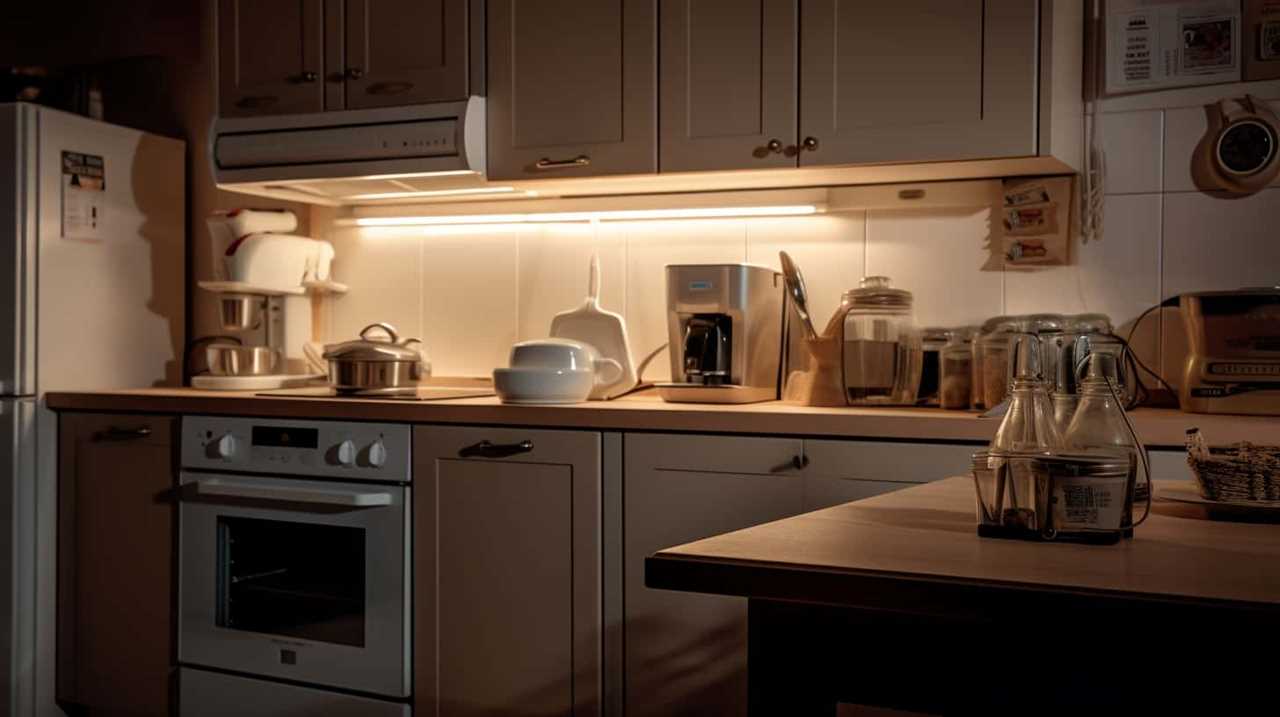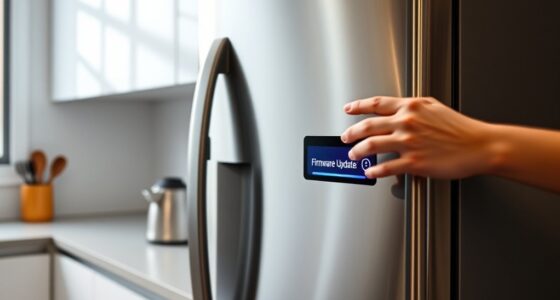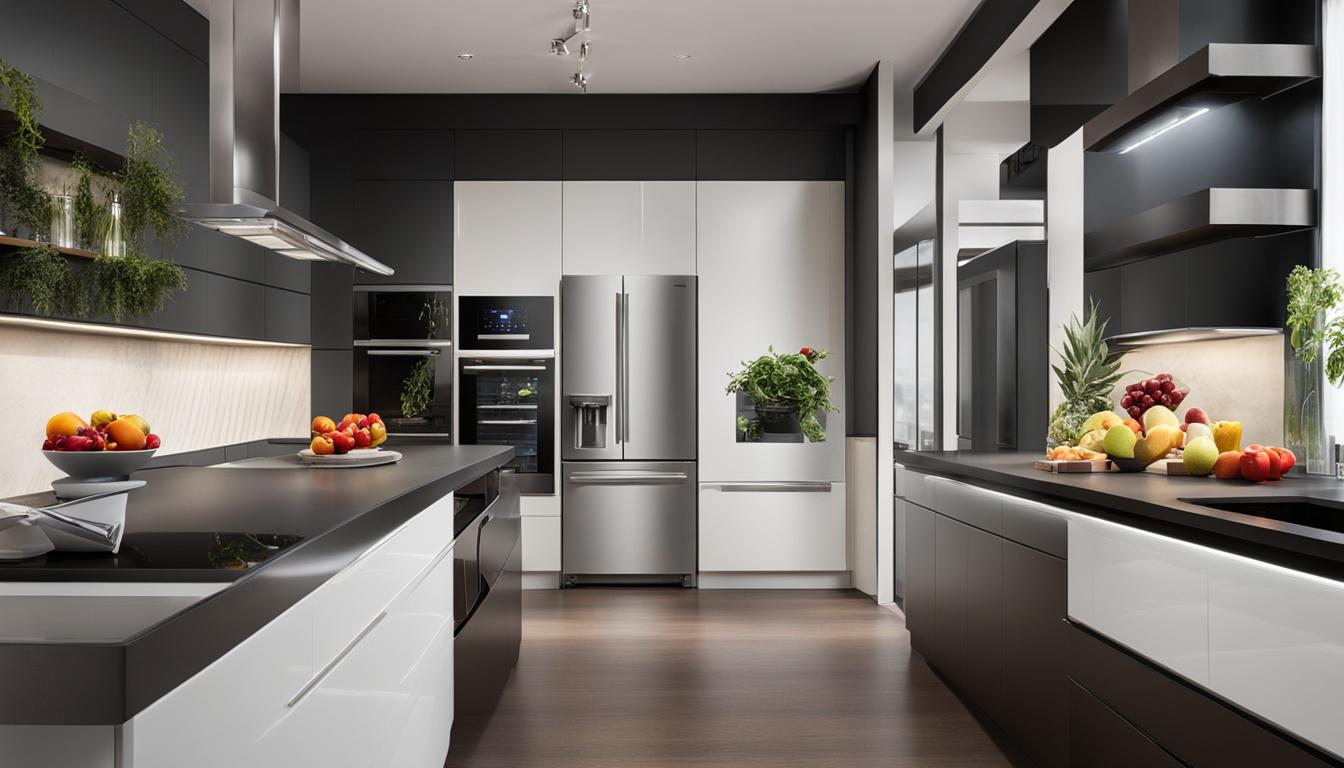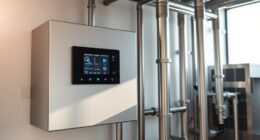As newcomers in the home appliance industry, we may not realize the many advantages that smart home appliances can provide. These state-of-the-art devices are created to improve our everyday lives through advanced technology and automation.
From cost-effective options to energy-efficient features, smart home appliances provide a range of advantages that can help us achieve mastery in managing our homes.
With simplified control through smartphone apps and integration with other smart devices, we can effortlessly streamline our routines and create a more convenient living environment.
Furthermore, the ability to operate these appliances through voice control adds a hands-free element to our daily tasks.

By choosing smart home appliances, we not only increase the value of our homes, but also future-proof our living spaces with the latest advancements in technology.
Key Takeaways
- Smart home appliances offer cost-effective and energy-efficient options for beginners.
- Simplified control and integration allow for easy setup and management of smart appliances.
- Future-proofing and staying up-to-date with the latest technology advancements is possible with smart appliances.
- Smart home appliances enhance convenience and simplify household management through time-saving automation features.
Cost-Effective Options for Beginners
As beginners, we can find cost-effective options for smart home appliances. When starting our journey into the world of smart home technology, it’s important to consider our budget and look for options that offer the best value for money. Thankfully, there are numerous cost-effective options available in the market today.
One key aspect to look for in cost-effective smart home appliances is beginner-friendly features. These features make it easier for us to set up and integrate these devices into our homes without the need for extensive technical knowledge. For example, some smart thermostats come with intuitive interfaces and step-by-step installation guides, allowing us to easily control the temperature of our homes and save on energy costs.
Another cost-effective option is to choose smart appliances that can be controlled through a hub or a central system. This allows us to control multiple devices with a single app or voice command. By investing in a hub, we can avoid the need to purchase separate smart devices for each appliance, saving us money in the long run.

Energy-Efficient Features to Save Money
To further maximize our savings, we can explore the energy-efficient features offered by smart home appliances. These appliances are designed to consume less energy, helping us reduce our electricity bills and contribute to a more sustainable environment. One of the energy-saving tips is to choose appliances that have earned the ENERGY STAR certification. This label ensures that the appliance meets strict energy efficiency guidelines set by the U.S. Environmental Protection Agency.
Smart home appliances also offer various eco-friendly options. For example, many smart thermostats have the ability to learn our temperature preferences and adjust the heating or cooling accordingly. This feature helps us save energy by avoiding unnecessary heating or cooling when we aren’t at home. Additionally, some smart appliances can be controlled remotely through smartphone apps, allowing us to turn them off or adjust their settings even when we’re away from home.
Furthermore, smart home appliances often come equipped with sensors that can detect when no one is in the room, automatically turning off lights or reducing power consumption. They can also provide real-time energy usage data, allowing us to monitor and optimize our energy consumption.
Simplified Control Through Smartphone Apps
Smart home appliances offer simplified control through smartphone apps, allowing us to conveniently manage and monitor our devices from anywhere. With the advancement of smart home automation, controlling our appliances has never been easier. Here are four reasons why smartphone apps are an essential feature for remote device control:

- Accessibility: Smartphone apps provide us with the convenience of controlling our smart home appliances from anywhere, as long as we’ve an internet connection. Whether we’re at work, on vacation, or simply in another room, we can easily monitor and adjust our devices with a few taps on our phone.
- Customization: These apps allow us to customize our device settings according to our preferences. We can create schedules, set timers, and create personalized routines to automate our appliances. For example, we can set our lights to turn on at sunset or adjust our thermostat to maintain a comfortable temperature throughout the day.
- Real-time monitoring: Smartphone apps enable real-time monitoring of our smart home appliances. We can check the status of our devices, such as whether the lights are on or off, the temperature of our refrigerator, or even receive notifications when a device requires attention or maintenance.
- Integration: Many smartphone apps for smart home appliances offer integration with other devices and platforms. This means that we can control multiple devices from different manufacturers within a single app. For example, we can control our smart lights, thermostat, and security system all from one app, providing a seamless and unified experience.
With the simplified control provided by smartphone apps, managing our smart home appliances becomes effortless. We can enjoy the convenience, customization, real-time monitoring, and integration that these apps offer, making our lives more efficient and comfortable.
Integration With Other Smart Devices
When it comes to smart home appliances, one of the key advantages is their integration with other smart devices.
This integration allows for enhanced home automation capabilities, making it easy to control multiple devices through a single interface.
With the ability to connect and communicate with other smart devices, such as smart speakers, thermostats, and security systems, users can create a seamless and interconnected smart home ecosystem.

Enhanced Home Automation Capabilities
Our homes become more interconnected and efficient with the enhanced automation capabilities offered by integrating smart home appliances with other devices. This integration allows for seamless communication between different smart devices, resulting in a more advanced and sophisticated home automation system.
Here are some key benefits of enhanced home automation capabilities:
- Energy consumption optimization: By integrating smart appliances with other devices, you can create a synchronized system that optimizes energy usage based on your preferences and patterns. This can lead to significant energy savings and reduced utility bills.
- Advanced technology integration: Smart home appliances can integrate with other advanced technologies such as voice assistants, smart speakers, and wearable devices. This allows for enhanced control and convenience, as you can control your appliances using voice commands or through your smart devices.
- Centralized control: With enhanced automation capabilities, you can control multiple devices through a single interface or app. This centralized control simplifies the management of your smart home ecosystem, making it easier to monitor and adjust settings.
- Customizable automation routines: Integration with other smart devices enables the creation of customized automation routines. This means you can set up specific actions to occur automatically based on triggers such as time, location, or sensor inputs. This level of customization enhances the efficiency and convenience of your smart home system.
Simplified Smart Device Control
With the integration of smart home appliances with other devices, we can simplify the control of our smart devices. This simplified device management allows us to control multiple devices from a single interface, eliminating the need to toggle between different apps or devices. By connecting our smart devices, such as lights, thermostats, and security cameras, to a central hub or using a smart speaker, we can effortlessly control them all with just a few taps or voice commands. Additionally, remote control capabilities enable us to manage our smart devices even when we are not at home. Whether it’s adjusting the temperature, turning off lights, or checking security cameras, we have complete control over our smart home ecosystem from anywhere in the world.
| Device | Function | Control Method |
|---|---|---|
| Lights | Illumination | App or Voice |
| Thermostat | Temperature | App or Voice |
| Security Camera | Surveillance | App or Voice |
| Smart Lock | Access Control | App or Voice |
| Entertainment System | Media Control | App or Voice |
Enhanced Convenience in Daily Routines
When it comes to smart home appliances, one of the key benefits is the enhanced convenience they bring to our daily routines.

These appliances are equipped with time-saving automation features that can help us streamline our tasks and save precious time throughout the day.
They also simplify household management by allowing us to control and monitor various aspects of our homes with just a few taps on our smartphones or voice commands.
Time-Saving Automation Features
Smart home appliances offer beginners the convenience of time-saving automation features. These features not only enhance the convenience in daily routines but also provide efficiency benefits and effective time management. Here are four examples of time-saving automation features that smart home appliances can provide:
- Automated Scheduling: Smart home appliances can be programmed to perform tasks at specific times, allowing you to automate your daily routines. For example, you can schedule your coffee maker to start brewing coffee before you wake up.
- Remote Control: With smart home appliances, you can control and monitor your devices remotely through your smartphone or voice commands. This eliminates the need to manually operate appliances, saving you time and effort.
- Energy Optimization: Smart home appliances can analyze your energy consumption patterns and adjust settings accordingly, optimizing energy usage and reducing wastage. This not only saves you money but also time spent on manually adjusting settings.
- Personalized Settings: Smart home appliances can learn your preferences and adapt to your needs. For example, a smart thermostat can adjust the temperature based on your schedule, ensuring comfort and saving you time spent on manual adjustments.
Simplified Household Management
As beginners, we can experience enhanced convenience in our daily routines through simplified household management offered by smart home appliances. These appliances provide simplified organization and efficient time management, making our lives easier and more efficient.

With smart home appliances, we can automate various tasks such as scheduling our appliances to turn on or off at specific times. For example, we can set our coffee machine to start brewing our favorite cup of coffee as soon as we wake up. This eliminates the need for manual intervention and ensures that our morning routine runs smoothly.
Additionally, smart home appliances can help us keep track of our household inventory. They can monitor our groceries and notify us when we’re running low on essential items. This feature eliminates the need for constant check-ins and helps us maintain a well-stocked pantry.
Streamlined Daily Tasks
We can experience enhanced convenience in our daily routines through the streamlined daily tasks offered by smart home appliances. These appliances provide a level of streamlined efficiency and time-saving automation that can greatly benefit our lives.
Here are four ways in which smart home appliances can streamline our daily tasks:

- Automated Cleaning: Smart vacuum cleaners can automatically clean our floors, saving us time and effort.
- Efficient Cooking: Smart ovens and microwaves can be programmed to cook our meals, ensuring they’re ready when we need them.
- Smart Laundry: Smart washing machines can be scheduled to start and finish the laundry, saving us time and energy.
- Intelligent Lighting: Smart lighting systems can be programmed to turn on and off automatically, creating a more efficient and convenient lighting experience.
Improved Safety and Security Measures
One of the key advantages of incorporating smart home appliances is the enhanced safety and security they provide. Smart home appliances are equipped with advanced technology and features that contribute to improved home safety and enhanced security measures. These appliances are designed to protect your home and loved ones from potential dangers and threats.
Smart home appliances offer various safety features such as motion sensors, door and window sensors, and smoke and carbon monoxide detectors. These sensors can detect any unusual activity or potential hazards and immediately send alerts to your smartphone, allowing you to take quick action.
Additionally, smart home appliances can be integrated with security cameras, enabling you to monitor your home remotely and have a clear view of any potential security breaches.
Moreover, smart home appliances offer enhanced security measures through features like remote locking systems and video doorbells. With remote locking systems, you can lock and unlock your doors using your smartphone, ensuring that your home is always secure. Video doorbells allow you to see and communicate with anyone at your doorstep, enhancing your security and enabling you to screen visitors before letting them in.

By incorporating smart home appliances, you can have peace of mind knowing that your home is equipped with improved safety features and enhanced security measures.
Moving forward, let’s explore the next section, which focuses on the remote monitoring and control capabilities of smart home appliances.
Remote Monitoring and Control Capabilities
We frequently use smart home appliances to remotely monitor and control our homes, thanks to their advanced capabilities and convenient features. With remote monitoring, we can keep an eye on our homes even when we’re away, giving us peace of mind and ensuring that everything is in order. Here are some key benefits of these capabilities:
- Enhanced security: Smart home appliances allow us to remotely monitor our security cameras, door locks, and alarm systems. We can receive real-time alerts and take immediate action in case of any suspicious activity, ensuring the safety of our homes.
- Convenience: We can control various aspects of our homes, such as lighting, temperature, and appliances, from anywhere using our smartphones or voice assistants. This saves us time and effort, and also allows us to create personalized schedules for energy efficiency.
- Energy savings: Smart home appliances enable us to monitor and control our energy usage. We can remotely adjust the thermostat, turn off lights and appliances, and even monitor energy consumption in real-time. This helps us reduce our energy bills and contribute to a greener environment.
- Peace of mind: With remote monitoring and control capabilities, we can check on our homes anytime, ensuring that everything is functioning properly. We can also receive alerts for potential issues, such as water leaks or power outages, allowing us to take immediate action and prevent any further damage.
Customizable Settings for Personalized Experience
To further enhance the user experience, smart home appliances offer customizable settings that allow us to personalize our homes according to our preferences and needs. These customizable settings enable us to create a personalized automation system that caters to our specific requirements. We can easily adjust various parameters such as temperature, lighting, and security settings to align with our customized preferences.

For instance, let’s consider a smart thermostat. With its customizable settings, we can create personalized temperature profiles for different times of the day or specific rooms in our home. This level of control ensures that our living spaces are always at the perfect temperature, whether it’s cozy warmth in the evenings or a cool environment during hot summer days.
Moreover, smart lighting systems allow us to customize the intensity, color, and timing of our lights. We can create lighting scenes for different occasions, such as a movie night or a romantic dinner, with just a few taps on our smartphone. This level of personalization not only enhances the ambiance of our home but also contributes to energy efficiency by adjusting the lighting based on our needs.
In the table below, we showcase some of the customizable settings available in smart home appliances:
| Appliance | Customizable Settings |
|---|---|
| Smart Thermostat | Temperature profiles for different times of the day or specific rooms |
| Smart Lighting | Intensity, color, and timing of lights for different occasions |
| Smart Security | Customized alarm settings and notification preferences for enhanced security |
| Smart Appliances | Personalized schedules for appliances like washing machines and dishwashers |
| Smart Entertainment | Customized settings for audio and video preferences, such as volume and screen size |
Time-Saving Automation Features
Continuing with the customizable settings, smart home appliances also offer time-saving automation features that streamline daily tasks. These features provide convenience and efficiency, allowing users to focus on more important aspects of their lives. Here are some of the time-saving automation features that smart home appliances offer:

- Scheduled Operations: With time-saving automation, users can schedule appliances to turn on or off at specific times. For example, you can set your coffee maker to start brewing your morning coffee just before you wake up, ensuring a fresh cup is ready for you.
- Remote Monitoring: Smart home appliances can be monitored and controlled remotely through smartphone apps. This allows users to check the status of their appliances, adjust settings, and even receive notifications when tasks are completed or if there are any issues. No more worrying about leaving appliances on or forgetting to turn them off!
- Smart Integrations: Smart home appliances can be integrated with other devices and systems, creating a seamless experience. For example, your smart thermostat can communicate with your smart blinds, adjusting the temperature and lighting in your home based on your preferences and daily routines.
- Voice Control: Many smart home appliances are compatible with voice assistants like Amazon Alexa or Google Assistant. This enables hands-free operation, allowing users to control their appliances with simple voice commands, further saving time and effort.
Learning Capabilities for Optimal Performance
As we delve into the topic of learning capabilities for optimal performance in smart home appliances, it’s worth noting that these features further enhance their efficiency and user experience. Smart home appliances are designed to adapt and learn from our behaviors and preferences, allowing them to perform tasks more efficiently and effectively over time.
Learning capabilities in smart home appliances enable them to gather data and analyze patterns to make intelligent decisions. For example, a smart thermostat can learn our temperature preferences and adjust accordingly, creating a comfortable environment without the need for constant manual adjustments. Similarly, a smart lighting system can learn our daily routines and automatically adjust the lighting levels based on our activities and preferences.
These learning capabilities also contribute to energy savings. By learning our habits and optimizing their performance accordingly, smart home appliances can reduce energy consumption and lower utility bills. For instance, a smart dishwasher can learn the most energy-efficient cycle for cleaning our dishes, while a smart washing machine can adjust the water temperature and cycle length based on our laundry habits.
In addition to improving efficiency and energy savings, learning capabilities also enhance the overall user experience. By adapting to our preferences and behaviors, smart home appliances provide a personalized and convenient experience. They can anticipate our needs, automate routine tasks, and even suggest improvements to optimize our daily routines.

Easy Installation and Setup Process
The installation and setup process for smart home appliances is straightforward and hassle-free, making it easy for us to incorporate these advanced technologies into our homes. Here are four reasons why the installation and setup process is user-friendly:
- Clear instructions: Smart home appliances come with detailed instructions that guide us through the installation and setup process. These instructions are easy to follow, even for beginners.
- Minimal wiring: Unlike traditional appliances, smart home appliances often require minimal wiring. Most of them can be connected to our existing Wi-Fi network, eliminating the need for complex wiring installations.
- Mobile apps: Smart home appliances usually come with dedicated mobile apps that simplify the setup process. These apps provide step-by-step instructions and intuitive interfaces, allowing us to configure the appliances with ease.
- Plug-and-play compatibility: Many smart home appliances are designed to be plug-and-play compatible. This means that we can simply plug them into a power source and connect them to our home network without any additional setup steps.
With the easy installation and user-friendly setup process, it becomes effortless for us to incorporate smart home appliances into our daily lives. This convenience sets the stage for the next section, where we’ll explore voice control for hands-free operation.
Voice Control for Hands-Free Operation
Now let’s delve into the convenience of controlling our smart home appliances through voice commands. Voice control offers a hands-free operation that enhances the user experience and simplifies daily tasks. With the advancement of voice recognition technology, smart home appliances can now be seamlessly integrated with automated assistants such as Amazon Alexa, Google Assistant, or Apple Siri.
Voice recognition technology allows users to control their smart home appliances simply by speaking commands. Whether it’s adjusting the thermostat, turning on the lights, or even starting the coffee maker, all it takes is a voice command. This not only saves time but also eliminates the need to physically interact with the devices.

Automated assistants act as a bridge between the user’s voice commands and the smart home appliances. They interpret the spoken instructions and communicate with the respective devices to execute the requested actions. This integration provides a seamless and intuitive experience, making it easy for beginners to adapt to smart home technology.
Furthermore, voice control offers a hands-free operation, freeing up our hands to focus on other tasks. Whether we’re cooking in the kitchen, doing household chores, or simply relaxing on the couch, we can effortlessly control our smart home appliances without needing to reach for a remote control or a smartphone.
Smart Home Appliance Compatibility
When it comes to smart home appliance compatibility, there are two important points to consider.
First, you need to look at the device integration options to ensure that the appliances you choose can easily connect with other smart devices in your home.

Second, it’s crucial to check if the appliances are compatible with your existing systems, such as your home automation hub or voice assistant.
Ensuring compatibility will allow for seamless integration and a more efficient smart home experience.
Device Integration Options
How can we seamlessly integrate smart home appliances with other devices? Device compatibility is crucial when it comes to integrating smart home appliances into your existing setup. By ensuring that your devices are compatible, you can enjoy the full range of integration benefits. Here are four options for device integration:
- Hub-based Integration: Using a central hub, such as a smart speaker or a dedicated smart home hub, you can connect and control multiple devices using a single platform.
- Wi-Fi Integration: Many smart home appliances connect directly to your Wi-Fi network, allowing you to control them through a smartphone app or voice commands.
- Bluetooth Integration: Some devices use Bluetooth technology to connect and communicate with each other, enabling seamless integration without the need for a hub.
- Zigbee/Z-Wave Integration: These wireless protocols provide a mesh network for smart home devices, allowing for reliable and efficient communication between devices.
Compatibility With Existing Systems
As beginners in the world of smart home appliances, it’s important to consider the compatibility of these devices with our existing systems. When choosing smart appliances, one of the key factors to consider is their compatibility with other devices in our homes.

Smart home appliances that are compatible with existing systems allow for seamless integration and enhanced functionality. This means that we can control and automate various devices through a single app or voice commands, creating a unified and convenient smart home experience.
Additionally, compatibility with other devices ensures that our smart appliances can easily communicate and share information, enabling them to work together efficiently. This not only simplifies the setup process but also enhances the ease of use and overall user experience.
Considering compatibility with existing systems is crucial in ensuring that our smart home appliances work seamlessly with our other devices, making our lives more convenient and efficient.
Now let’s move on to the next section, which discusses how smart technology can increase the value of our homes.

Increased Home Value With Smart Technology
By implementing smart technology, we’ve seen a significant increase in the value of our home. Smart home appliances and systems offer a wide range of benefits, including cost-effective options that can enhance the value of your property.
Here are four reasons why smart technology can increase your home value:
- Energy efficiency: Smart appliances are designed to optimize energy usage, resulting in lower utility bills. Potential buyers are attracted to homes with energy-saving features, making your property more desirable and valuable.
- Enhanced security: Smart security systems provide advanced protection against break-ins and other threats. The added security measures can increase the perceived value of your home, giving potential buyers peace of mind.
- Convenience and comfort: Smart technology allows homeowners to control various aspects of their home remotely. From adjusting the temperature to controlling lighting and entertainment systems, the convenience and comfort offered by smart appliances can make your home more appealing and valuable.
- Integration and automation: Smart home systems can be seamlessly integrated with other devices and technologies. This integration allows for automation and centralized control, enhancing the overall functionality of your home and increasing its value.
As we’ve experienced firsthand, incorporating smart technology into our home hasn’t only made our lives easier but has also significantly increased its value. With the increased demand for smart homes, investing in these technologies can future-proof your home and ensure its value continues to grow.
Future-Proofing Your Home With Smart Appliances
When it comes to future-proofing your home, smart appliances are a wise investment.

Not only do they offer cost savings in the long run, but they also provide energy efficiency benefits.
Cost Vs. Longevity
To future-proof our home with smart appliances, we prioritize the balance between cost and longevity. Making a smart investment in these devices not only provides us with convenience but also offers cost-saving benefits and durability advantages.
Here are the key factors to consider when weighing the cost versus longevity of smart home appliances:
- Initial cost: While smart appliances may have a higher upfront cost compared to traditional counterparts, they often provide long-term savings through energy efficiency and reduced utility bills.
- Lifespan: Smart appliances are designed to have a longer lifespan compared to conventional appliances, ensuring they’ll last for many years.
- Upgradability: Smart appliances can be updated with new features and functionalities through software upgrades, extending their lifespan and keeping them up-to-date with the latest technology.
- Resale value: Investing in high-quality smart appliances can increase the resale value of our home, making them a wise long-term investment.
Energy Efficiency Benefits
Continuing the discussion from the previous subtopic, we can now explore the energy efficiency benefits of smart appliances for future-proofing our home.

Smart appliances offer significant energy savings, making them a wise investment for environmentally conscious homeowners. These appliances are designed with advanced technology that allows them to operate more efficiently than traditional appliances.
They can be programmed to optimize energy usage, adjusting settings based on usage patterns and real-time data. By reducing energy consumption, smart appliances not only save homeowners money on utility bills but also have a positive environmental impact by reducing greenhouse gas emissions.
Additionally, some smart appliances can connect to renewable energy sources, further reducing their environmental footprint.
Investing in energy-efficient smart appliances is a smart choice for those looking to reduce their carbon footprint and save on energy costs.

Frequently Asked Questions
Can I Use Voice Control to Operate All Smart Home Appliances?
Yes, we can use voice control to operate most smart home appliances.
However, there are some limitations. Certain older appliances may not be compatible with voice control. Additionally, not all functions of a smart appliance can be controlled through voice commands.
In such cases, alternative control methods like smartphone apps or physical buttons can be used. It’s important to check the compatibility and features of each appliance before purchasing to ensure it meets your needs and preferences.
What Are Some Cost-Effective Options for Beginners Who Want to Start Building a Smart Home?
Affordable options for beginners who want to start building a smart home include DIY smart home kits. These kits provide a cost-effective way to transform your home into a smart home without breaking the bank.

With DIY smart home kits, you can easily install and set up smart devices such as smart lights, smart thermostats, and smart plugs. These kits often come with step-by-step instructions and all the necessary components, making it easy for beginners to get started on their smart home journey.
How Do Smart Home Appliances Enhance Convenience in Daily Routines?
Imagine a world where our daily routines are simplified, where time is saved, and convenience is at our fingertips. Smart home appliances make this a reality. With their time-saving features and seamless integration with other devices and systems, they enhance convenience in our daily lives.
From automated lighting and temperature control to voice-activated assistants, these appliances revolutionize the way we interact with our homes. Embracing smart home technology as a beginner opens up a world of possibilities for streamlining and simplifying our routines.
Can I Monitor and Control My Smart Home Appliances Remotely When I Am Not at Home?
Yes, we can monitor and control our smart home appliances remotely even when we aren’t at home. This convenient feature allows us to easily turn appliances on or off, adjust settings, and receive real-time updates through our smartphones or other devices.

Additionally, smart home appliances often come with energy-saving features that allow us to optimize our energy usage, save money, and reduce our environmental footprint.
Do All Smart Home Appliances Have Learning Capabilities for Optimal Performance?
Do all smart home appliances have learning capabilities for optimal performance?
This is a common query among those interested in smart home technology. While not all smart appliances possess learning capabilities, many advanced models do.
Learning capabilities allow appliances to adapt to your preferences and adjust their settings accordingly, resulting in enhanced performance and efficiency.

This feature is particularly beneficial for beginners as it simplifies the process of using and managing smart home appliances, making them an ideal choice for those new to the technology.
What are the benefits of using smart home appliances in the kitchen for beginners?
For beginners, the best smart kitchen appliances can streamline cooking and make meal prep easier. These appliances can help control cooking temperatures, set timers, and even provide recipe ideas. Smart appliances can also save energy and optimize food storage, making them a great investment for anyone new to cooking.
Conclusion
In conclusion, opting for smart home appliances as a beginner is a smart move.
Not only do they offer cost-effective options, but they also come with energy-efficient features to save money in the long run.
The simplified control through smartphone apps and integration with other smart devices add convenience to daily routines.

With voice control for hands-free operation and compatibility with other smart home appliances, you can future-proof your home and increase its value.
Choosing smart appliances is like opening a door to a world of seamless automation.








